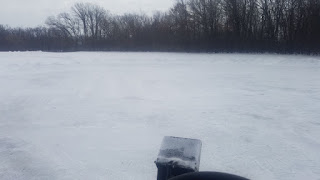Crown hydration is the main cause of winter damage in our area. The danger comes when the sun sets and the layer of water under the ice re-freezes as does the ice in the cell plants. Each time this happens more cells in the plants die until the plant can no longer recover.
To make a long story short snow is good for grass but ice is bad and we want to get rid of it as fast as we can especially in mid to late March when the sun is getting higher and has more power. We have a few methods to help speed up the "ice melt" when we see a warm spell coming. Without human help mother nature can takes days or weeks to melt the ice and snow off the greens. We cannot control mother nature but we can help her out.
First thing is to remove the snow from the greens to allow the warm sun to melt the ice without melting snow adding to the ice problem. This is normally done with our snow blower but we had so much ice and the right weather this year we were able to use the dump truck and plow to clear the greens.
 |
| Plowing the 4th green to remove snow to hasten ice melt. Removing the snow also reduces the chance of more ice building up from the melting snow. |
 |
| The putting green looks like a skating rink. |
Once we are down to the ice we used a combination of mother nature, shoveling the swales where the ice was thickest and darkening the ice to increase melting. We darken the ice buy using green dye and black sunflower seeds.
 |
| 15 green after 2.5 hours of snowblowing with our riding blower. |
 |
| Green dye hand sprayed on the ice on 15 green. |
We mark many of the key drains in fall so they are easy to find in the winter. This year James actually had to use a ice auger to go through the 12 to 18 inches of ice and snow to get down to the drain. It is through this preparation for the melt that we reduce our susceptibility to flooding and damage from water running where it isn't supposed to.
 |
| Sunflower seeds hand tossed on 5 green |
 |
| The seeds surround with a quarter for size relevance after the snow melt. What the birds and squirrels don't eat we will blow off the green. |
 |
| Sometimes hand work is needed to bust up the ice and hasten the melt. |
As always if you have any questions feel free to reach out to us.

No comments:
Post a Comment